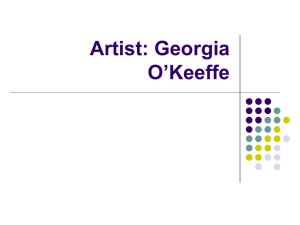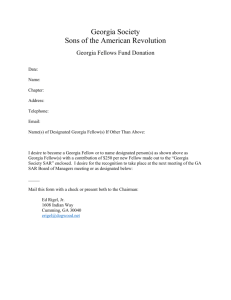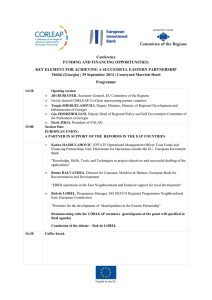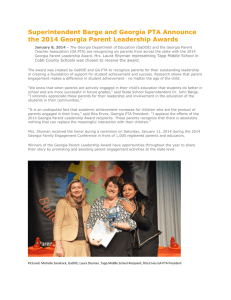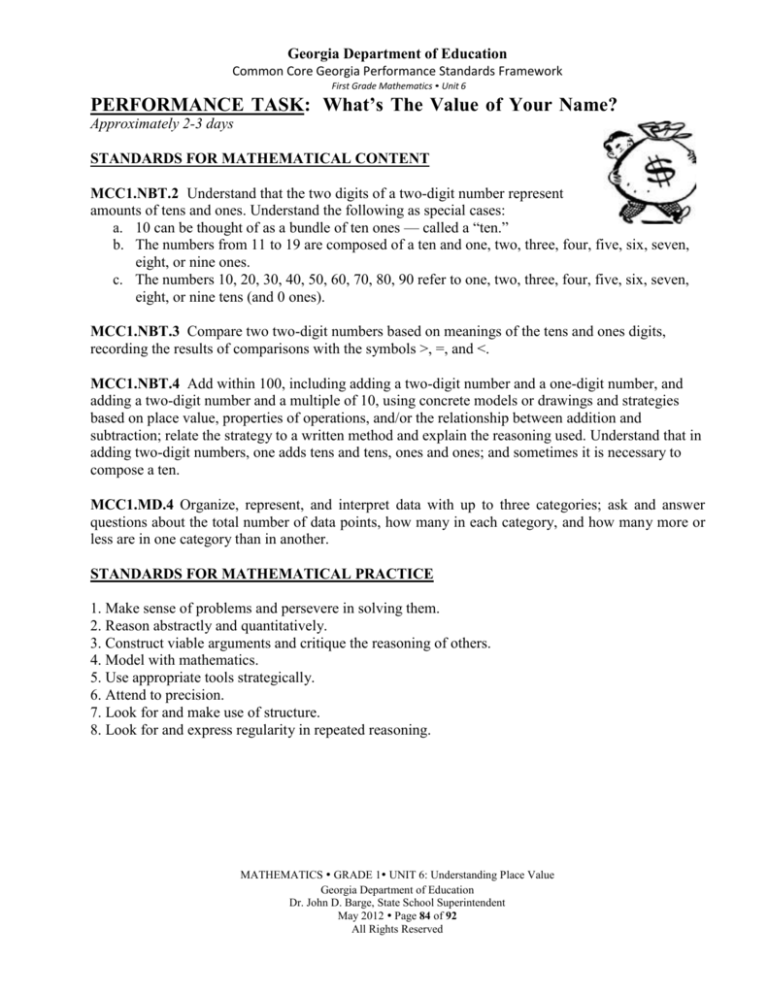
Georgia Department of Education
Common Core Georgia Performance Standards Framework
First Grade Mathematics • Unit 6
PERFORMANCE TASK: What’s The Value of Your Name?
Approximately 2-3 days
STANDARDS FOR MATHEMATICAL CONTENT
MCC1.NBT.2 Understand that the two digits of a two-digit number represent
amounts of tens and ones. Understand the following as special cases:
a. 10 can be thought of as a bundle of ten ones — called a “ten.”
b. The numbers from 11 to 19 are composed of a ten and one, two, three, four, five, six, seven,
eight, or nine ones.
c. The numbers 10, 20, 30, 40, 50, 60, 70, 80, 90 refer to one, two, three, four, five, six, seven,
eight, or nine tens (and 0 ones).
MCC1.NBT.3 Compare two two-digit numbers based on meanings of the tens and ones digits,
recording the results of comparisons with the symbols >, =, and <.
MCC1.NBT.4 Add within 100, including adding a two-digit number and a one-digit number, and
adding a two-digit number and a multiple of 10, using concrete models or drawings and strategies
based on place value, properties of operations, and/or the relationship between addition and
subtraction; relate the strategy to a written method and explain the reasoning used. Understand that in
adding two-digit numbers, one adds tens and tens, ones and ones; and sometimes it is necessary to
compose a ten.
MCC1.MD.4 Organize, represent, and interpret data with up to three categories; ask and answer
questions about the total number of data points, how many in each category, and how many more or
less are in one category than in another.
STANDARDS FOR MATHEMATICAL PRACTICE
1. Make sense of problems and persevere in solving them.
2. Reason abstractly and quantitatively.
3. Construct viable arguments and critique the reasoning of others.
4. Model with mathematics.
5. Use appropriate tools strategically.
6. Attend to precision.
7. Look for and make use of structure.
8. Look for and express regularity in repeated reasoning.
MATHEMATICS GRADE 1 UNIT 6: Understanding Place Value
Georgia Department of Education
Dr. John D. Barge, State School Superintendent
May 2012 Page 84 of 92
All Rights Reserved
Georgia Department of Education
Common Core Georgia Performance Standards Framework
First Grade Mathematics • Unit 6
BACKGROUND KNOWLEDGE
Money is not explicitly stated in the Common Core Georgia Performance Standards, but should still
be used in first grade classrooms. Teachers should use money and time as models and contexts for
counting. Using pennies allows the connection of counting by one’s and the concept of one more and
one less. Using dimes allows the connection of counting by 10’s and the concept of ten more and ten
less.
ESSENTIAL QUESTIONS
•
•
How can large quantities be counted efficiently?
How can benchmark numbers build my understanding of numbers?
MATERIALS
•
•
•
•
•
•
•
ABC Value Chart
“What’s the Value of My Name?” Recording sheet
Chrysanthemum by Kevin Henkes or similar book
Manipulatives such as paper money, coins, and/or base 10 blocks to support different learning
styles
Name Value Data Collection Chart
Math Story Organizer
Chart paper
GROUPING
Individual, Large Group and Partner
TASK DESCRIPTION, DEVELOPMENT, AND DISCUSSION
Part I
Gather students together in a common area. Read the book Chrysanthemum by Kevin Henkes, or a
similar text. Make a list of the names from the book. These will be used as part of the extension of
the task. Display the ABC Value chart and discuss how each letter represents a value. Ask students,
“How can you determine the total value for your name? “ Once they suggest adding values for each
letter together, model a “Think Aloud.” Model for students how you can find the value of your
name using base 10 blocks or any other small manipulative. Discuss that the chart has money
amounts but they can also represent these amounts using small manipulatives. Use the recording
sheet to write your first name. Show students how to read the chart to find the value of each letter in
your name.
MATHEMATICS GRADE 1 UNIT 6: Understanding Place Value
Georgia Department of Education
Dr. John D. Barge, State School Superintendent
May 2012 Page 85 of 92
All Rights Reserved
Georgia Department of Education
Common Core Georgia Performance Standards Framework
First Grade Mathematics • Unit 6
After recording the values for each letter in your name, orally model your thinking about an
estimation of the value of your name. Discuss how you are using your knowledge of numbers to
make your estimation. For example, if your name was Juli (note the name Juli without an “e”), you
would record 10, 21, 12 and 9, for the values of the letters in your name.
Then demonstrate how to use the closest ten to determine an estimate. Say, “I can already use 10
easily; I will think of 21 as 20, 12 as 10 and 9 as 10, this will make it much easier to mentally
determine the estimated value of my name. 10 and 20 is 30 and another 10 makes 40, and more ten
makes 50. So my estimate for my name is 50¢.” Write this estimate on the recording sheet. “Now
that I have an estimate to guide my thinking, I will figure out the actual value of my name. J is my
first letter and it’s worth 10 ¢, U is my second letter and is worth 21¢. I will combine these two
amounts for a new total.” (The teacher should use base 10 blocks or other small counters to represent
these two amounts) Then say, “I have 41 now, but I still have 2 more letters in my name. My next
letter is L and it is worth 12¢, so I need to add 41¢ to 12¢ to get my new total. (The teacher again
models adding 41¢ to 12¢ with base 10 blocks or other small counters and a place value mat.)
Teacher continues by saying, “I have one more letter to add to my name value. My last letter is I and
is worth 9 ¢.” (The teacher again models adding 53¢ to 9¢ with base 10 blocks or other small
counters and a place value mat. This would be a good opportunity to model adding by using ten as a
benchmark number and then subtracting one because 9 is one less than 10.) Conclude the example
by saying, “I used base 10 blocks to model adding the values in my name. What other models could
you use to add the values? (Give students an opportunity to share their ideas which include: coins,
base ten pictures, tally marks, drawing pictures or another strategy)
Part II
Have students calculate the value of their names. Once all students have determined the value of their
name, display the “Name Value Data Collection Chart” and have students record their findings on the
chart for later discussions.
• As students are working, walk around the room to offer assistance and observe the strategies
selected to determine their name value.
• After recording data on the chart, use the Data Collection Sheet to promote discussions. Guide
students through completion of comparisons – Each student will have different answers
depending on their individual name value.
• Tell students to look at the value of their name. How could they use currency (bills and change)
to show the value of their name? Have them use the money in the classroom to count out the
combinations and create a drawing on the recording sheet.
Part III
With the completed “Name Value Data Collection Chart”, model a word problem using the Math
Story Organizer on chart paper. Make sure students understand what to put in each section. Then
pose a story problem to the entire class. Allow the students to work with a partner and have
manipulatives available. Students may fill out the Math Story Organizer independently or with a
partner.
Example Story Problem: Heath and Megan are worth 82 cents together. Find 3 students
whose combined value is less than Heath and Megan’s.
MATHEMATICS GRADE 1 UNIT 6: Understanding Place Value
Georgia Department of Education
Dr. John D. Barge, State School Superintendent
May 2012 Page 86 of 92
All Rights Reserved
Georgia Department of Education
Common Core Georgia Performance Standards Framework
First Grade Mathematics • Unit 6
FORMATIVE ASSESSMENT QUESTIONS
•
•
•
•
•
How can you make a comparison using the terms greater than, less than, and equal to?
How can you use coins to help you count or add numbers?
Can you represent the number ____ with a collection of objects using tens and ones?
How can you add two larger numbers efficiently and accurately?
How can you compare two amounts using words and symbols?
DIFFERENTIATION
Extension
• Have students use the same chart to discover the value of a state name. Allow them to explore
the United States Map and compare the value of two states. Students could also find the value of
five states and then put them in order from the least value to the highest value.
• Allow students to determine the value of different teacher’s names within the building. Make
estimations about whose name might have the highest and lowest value.
Intervention
• This lesson could be modified by using single digit numbers in lieu of the larger numbers (see
attached chart below for the remediation idea) or the teacher could provide students with some
names that are only three letters long, such as Bob, Tim, Zoe, Fay, Kay while using the chart with
the larger digits. They would make comparisons with the names given in lieu of their name. It
might also be helpful for students with long names who are overwhelmed to work with parts of
their name at a time. Or try the same intervention as above, with vowels worth 5¢ and consonants
2¢.
Intervention Chart
A
0
G
6
M
1
S
7
B
1
H
7
N
2
T
8
C
2
I
8
O
3
U
9
D
3
J
9
P
4
V
10
E
4
K
10
Q
5
W
0
F
5
L
0
R
6
X
1
Y
2
Z
3
MATHEMATICS GRADE 1 UNIT 6: Understanding Place Value
Georgia Department of Education
Dr. John D. Barge, State School Superintendent
May 2012 Page 87 of 92
All Rights Reserved
Georgia Department of Education
Common Core Georgia Performance Standards Framework
First Grade Mathematics • Unit 6
ABC Value Chart
A
1¢
N
14¢
B
2¢
O
15¢
C
3¢
P
16¢
D
4¢
Q
17¢
E
5¢
R
18¢
F
6¢
S
19¢
G
7¢
T
20¢
H
8¢
U
21¢
I
9¢
V
22¢
J
10¢
W
23¢
K
11¢
X
24¢
L
12¢
Y
25¢
M
13¢
Z
26¢
MATHEMATICS GRADE 1 UNIT 6: Understanding Place Value
Georgia Department of Education
Dr. John D. Barge, State School Superintendent
May 2012 Page 88 of 92
All Rights Reserved
Georgia Department of Education
Common Core Georgia Performance Standards Framework
First Grade Mathematics • Unit 6
Whose Name is Worth the Most, the Least, the Same?
My name:
__
Letters:
Values:
My Estimated Value:
My name is worth
My Actual Value:
. I know this because
.
I can show the total value of my name in two different ways:
1.
2.
MATHEMATICS GRADE 1 UNIT 6: Understanding Place Value
Georgia Department of Education
Dr. John D. Barge, State School Superintendent
May 2012 Page 89 of 92
All Rights Reserved
Georgia Department of Education
Common Core Georgia Performance Standards Framework
First Grade Mathematics • Unit 6
My Name_______________
Partner’s Name_______________
Value _________________
Value _________________
1.
My partner’s name is worth
.
2.
Check one of the boxes below and complete the sentence.
My value of my name is _____ more than my partner’s name.
My value of my name is _____ less than my partner’s name.
My partner’s name has the same value as my name.
3.
How many students in the class have names of lesser value than your name?
Name two of these students: ________________________________________
4.
How many students in the class have name of greater value than your name? _____
Name two of these students: _______________________________________
5.
Who has a name with the same value as your name?
6.
Complete the following table below.
Name
Choose one:
less than
greater than
equal to
MATHEMATICS GRADE 1 UNIT 6: Understanding Place Value
Georgia Department of Education
Dr. John D. Barge, State School Superintendent
May 2012 Page 90 of 92
All Rights Reserve
Name



